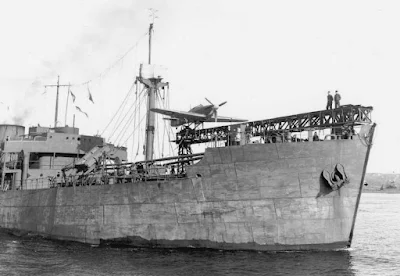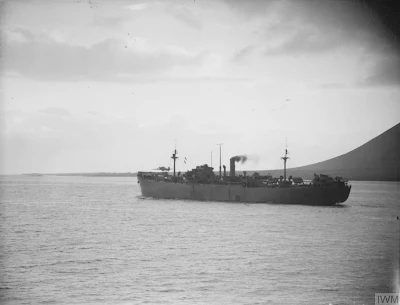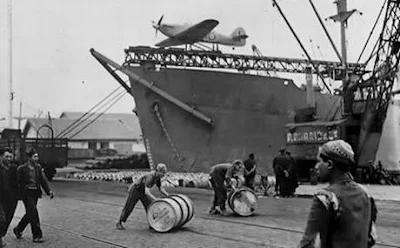CAM ships were World War II-era British merchant ships used in convoys as an emergency stop-gap until sufficient escort carriers became available. CAM ship is an acronym for catapult aircraft merchant ship. A CAM ship was equipped with a rocket-propelled catapult launching a single Hawker Hurricane, dubbed a "Hurricat" or "Catafighter." CAM ships continued to carry their normal cargoes after conversion.
The German Luftwaffe had Focke-Wulf Fw 200 "Kondor" aircraft with a range of nearly 2,000 nautical miles. After the Fall of France, these aircraft could operate from western France against British merchant ships in the Atlantic. Flying from Bordeaux - Mérignac Airport, Fw 200s of I/KG40 could reach the convoy lanes west of Britain while staying outside the range of British land-based fighters. The Royal Navy had no aircraft carriers available to provide close air cover for the convoys. The Fw 200s could shadow convoys, directing U-boat attacks on them, or drop bombs on convoy ships, without opposition and to deadly effect.
To counter this threat, the Admiralty developed the fighter catapult ship - a converted freighter, manned by a naval crew, carrying a single Hawker Hurricane fighter. When an enemy bomber was sighted, the fighter would be launched into the air with rockets, and fly up to destroy or drive away the bomber. (The Fw 200 was actually a rather vulnerable aircraft.) After the combat, the fighter pilot would bail out or ditch in the ocean near the convoy, and be picked up if all went well.
The Admiralty had already experimented with this system. They ordered 50 rocket-propelled aircraft catapults to be fitted to merchant ships. The planes were Hurricane Mark Is, converted to Sea Hurricane IAs.
The pilots for these aircraft were drawn from the Royal Air Force (RAF). The RAF formed the Merchant Ship Fighter Unit (MSFU) on 5 May 1941 in RAF Speke by the River Mersey in Liverpool. Wing Commander E.S. Moulton-Barrett commanded the unit providing training for volunteer pilots, Fighter Direction Officers (FDOs), and airmen. After training, MSFU crews were posted to Liverpool, Glasgow, or Avonmouth where they assisted in loading their Hurricanes onto the catapults. Each team consisted of one pilot for Atlantic runs (or two pilots for voyages to Russia, Gibraltar, or the Mediterranean Sea), with one fitter, one rigger, one radio-telephone operator, one FDO, and a seaman torpedoman who worked on the catapult as an electrician.
MSFU crews signed ship's articles as civilian crew members under the authority of the civilian ship's master. The ship's chief engineer became responsible for the catapult, and the first mate acted as Catapult Duty Officer (CDO), responsible for firing the catapult when directed. The single Hurricane fighter was launched only when enemy aircraft were sighted and agreement was reached via hand and flag signals between the pilot, CDO, and ship's master.
The first four or five ships were taken into Royal Navy service as "Auxiliary Fighter Catapult Ships," and later conversions were officially named CAMs manned by merchant crews. The first CAM ship, Michael E, was sponsored by the Royal Navy while the RAF MSFUs were working up. After a trial launch off Belfast, Michael E sailed with convoy OB 327 on 28 May 1941. She was sunk by U-108 on 2 June. The first RAF trial CAM launch was from Empire Rainbow, at Greenock on the River Clyde on 31 May 1941; the Hurricane landed at Abbotsinch. Six CAM ships joined convoys in June 1941. When a CAM ship arrived at its destination, the pilot usually launched and landed at a nearby airfield to get in as much flight time as possible before his return trip. Pilots were rotated out of CAM assignments after two round-trip voyages to avoid the deterioration of flying skills from the lack of flying time during the assignment.
CAM sailings were initially limited to North American convoys with aircraft maintenance performed by the Royal Canadian Air Force at Dartmouth, Nova Scotia. CAM ships sailed on Gibraltar and Freetown convoys beginning in September, 1941, after an aircraft maintenance unit was established at the RAF base at North Front, Gibraltar. No CAM aircraft were provided during January and February 1942 after it proved impossible to maintain the catapult-mounted aircraft in flying order during the North Atlantic winter. CAM sailings resumed on 6 March 1942 on North Atlantic convoys and in April on the Arctic Russian convoys with a RAF aircraft maintenance unit in Archangelsk.
Eight CAM ships were requisitioned from private owners, two of which were sunk: Daghestan, Daltonhall, Eastern City, Helencrest, Kafiristan, Michael E (sunk), Novelist, Primrose Hill (sunk).
27 CAM ships were Ministry of War Transport owned Empire ships, ten of which were sunk: Empire Burton (sunk), Empire Clive, Empire Darwin, Empire Day, Empire Dell (sunk), Empire Eve (sunk), Empire Faith, Empire Flame, Empire Foam, Empire Franklin, Empire Gale, Empire Heath, Empire Hudson (sunk), Empire Lawrence (sunk), Empire Moon, Empire Morn, Empire Ocean, Empire Rainbow (sunk), Empire Ray, Empire Rowan (sunk), Empire Shackleton (sunk), Empire Spray, Empire Spring (sunk), Empire Stanley, Empire Sun, Empire Tide, Empire Wave (sunk).
Take-off Procedure
The trolley receiving bar was removed at dawn.
The airmen started the aircraft and warmed up the engine at intervals.
The pilot climbed into the aircraft when enemy aircraft were reported.
The ship hoisted the international flag code F when the decision was made to launch. (CAM ships were usually stationed at the head of the outboard port column of a convoy so they could maneuver into the wind for launch.)
An airman removed the pins, showed them to the pilot, and took them to the CDO.
The pilot applied 30 degree flaps and 1/3 right rudder.
The CDO raised a blue flag above his head to inform the ship's master of his readiness to launch.
The ship's master maneuvered the ship into the wind and raised a blue flag above his head to authorize the launch. (The ship's master stood on the starboard bridge wing to avoid the catapult rocket blast which sometimes damaged the port side of the bridge.)
The CDO waved his blue flag indicating he was ready to launch upon a signal from the pilot.
The pilot opened full throttle, tightened the throttle friction nut, pressed his head back into the head-rest, pressed his right elbow tightly against his hip, and lowered his left hand as a signal to launch.
The CDO counted to three, waited for the bow to rise from the trough of a swell, and moved the switch to fire the catapult rockets.
CAM Combat Launches
|
Date |
Ship/convoy |
Pilot |
Outcome |
|
3 Aug 1941 |
HMS Maplin / OG 17 |
Lt R. Everett RNVR |
Focke-Wulf Fw 200 Condor shot down; pilot recovered by a destroyer |
|
1 Nov 1941 |
SS Empire Foam |
FO Varley |
Focke-Wulf Fw 200 chased off; pilot recovered by HMS Broke |
|
26 Apr 1942 |
SS Empire Morn / QP 12 |
FO JB Kendal |
Blohm & Voss BV 138 chased off and Junkers Ju 88 shot down (Ju 88A-4 "4D+IT" of III./KG 30); Kendal died from injuries received while bailing out |
|
26 May 1942 |
SS Empire Lawrence / PQ 16 |
PO Hay |
Two Heinkel He 111s shot down; Hurricane shot down, pilot wounded and recovered by HMS Volunteer |
|
14 Jun 1942 |
SS Empire Moon / HG 84 |
PO Sanders |
Focke-Wulf Fw 200 chased off; pilot recovered by HMS Stork |
|
18 Sep 1942 |
SS Empire Morn |
FO AH Burr |
Two Heinkel He 111s destroyed; pilot flew to the Russian Keg Ostrov aerodrome |
|
1 Nov 1942 |
SS Empire Heath / HG 91 |
FO N Taylor |
Focke-Wulf Fw 200 shot down; pilot nearly drowned before recovery |
|
28 Jul 1943 |
SS Empire Darwin / SL 133 |
FO JA Stewart |
Focke-Wulf Fw 200 destroyed; pilot recovered by HMS Leith |
|
28 Jul 1943 |
MV Empire Tide / SL 133 |
FO PJR Flynn |
Focke-Wulf Fw 200 destroyed; pilot recovered by HMS Enchantress |
In total, there were nine combat launches. Eight aircraft and one pilot were lost for eight German aircraft destroyed and one damaged.
As adequate numbers of escort carriers became available, CAM sailings on North American and Arctic Russian convoys were discontinued in August 1942. The aircraft maintenance unit was withdrawn from Archangel in September 1942. Catapults were removed from ten of the 26 surviving CAM ships while the remaining 16 continued to sail with the Mediterranean and Freetown convoys. Headquarters RAF Fighter Command ordered all MSFUs to be disbanded commencing 8 June 1943. The combat launches from homeward bound convoy SL 133 were from the last two operational CAM ships to sail, the last MSFU was disbanded 7 September 1943. Twelve of the 35 CAM ships had been sunk while sailing on 170 round trip voyages. Two more ships, Cape Clear and City of Johannesburg, were briefly fitted with dummy catapults and aircraft for deception purposes in late 1941.
 |
| The bow-mounted catapult on a CAM ship with a Sea Hurricane loaded. |
 |
| MS Empire Spray underway, at sea. |
 |
| A Hawker Hurricane Mark I of the Merchant Ship is craned aboard a Catapult Armed Merchant (CAM) ship at Gibraltar. The MSFU operated within No. 9 Group, RAF Fighter Command. 1942. |
 |
| A Hawker Sea Hurricane Mark I of the Merchant Ship Fighter Unit being placed on the steam catapult of a Catapult Armed Merchant (CAM) ship at Gibraltar. |
 |
| MSFU Sea Hurricane with her two pilots, Flight-Lieut. D. R. Turley-George (left) and the spare pilot Flying Officer C. Fenwick, aboard CAM ship SS Empire Tide at Hvalfjord, Iceland, 14 June 1942. |
 |
| Hawker Sea Hurricane Mark I, Z4936 'KE-M', of the Merchant Ship Fighter Unit, is fired from the training catapult at Speke, Liverpool. |
 |
| A Hawker Sea Hurricane Mk IA on the catapult of a CAM [Catapult Armed Merchant] Ship. |
 |
| A Hawker Sea Hurricane Mk IA mounted on a catapult in the bows of a CAM [Catapult Armed Merchant] Ship. |
 |
| FCS (Fighter Catapult Ship) and anti-aircraft ship, HMS Springbank, underway at sea during a convoy. |
 |
| The pilot of a Hawker Sea Hurricane receiving final instructions before climbing into his plane on the catapult of a catapult armed merchant (CAM) ship at Greenock. |
 |
| The Ariguani being towed by Clyde tugs. HMS Samsonia is seen alongside. |
 |
| The Samsonia alongside Ariguani. |
 |
| The Samsonia alongside the damaged HMS Ariguani at Greenock. |
 |
| Close up of damage to the stern of catapult ship Ariguani which was hit by a torpedo but nevertheless reached port safely for repairs. |
 |
| Aerial photograph of SS Empire Darwin, clearly showing defensive catapult-mounted Hawker Sea Hurricane fighter aircraft. |
 |
| The CAM ship Empire Faith. |
 |
| Empire Day. |
 |
| Empire Franklin after CAM conversion. |
 |
| MSFU Sea Hurricane I aboard a CAM ship. |
 |
| MSFU Sea Hurricane Ia V7070 aboard CAM ship Empire Heath 1942. |
 |
| MSFU Sea Hurricane Ia V7070 aboard CAM ship Empire Heath 1942. |
 |
| Hurricane Mk I NJ-L V6756 on a CAM ship catapult. |
 |
| MSFU Sea Hurricane I KE-M Z4936 being lowered onto a training catapult at Liverpool. |
 |
| CAM ship with Hurricane on catapult. |
 |
| CAM ship with Hurricane on catapult in convoy. |
 |
| CAM ship with Hurricane on catapult. |
 |
| HMS Empire Larence, circa 1941, at anchor, with Hurricane on catapult. |
 |
| Fighter Catapult Ship HMS Ariguani with Fulmer on the catapult seen on the Clyde, 5 June 1941. |
 |
| MSFU Sea Hurricane aboard CAM ship Empire Lawrence at Hvalfjord, Iceland, May 1942.. |
 |
| Hawker Hurricane being loaded on a CAM ship, Newport docks. |
 |
| A Sea Hurricane of the Merchant Ship Fighter Unit, on the catapult aboard the CAM ship (Catapult Armed Merchantman) SS Empire Darwin, in a convoy heading for North Africa, 1943. |
 |
| Merchant Ship Fighter Unit Sea Hurricane Mk IA V7504 on the catapult of a CAM ship. |
 |
| MSFU Sea Hurricane aboard CAM ship SS Empire Tide at Hvalfjord, Iceland, 14 June 1942. |
 |
| MSFU Merchant Ship Fighting Unit Sea Hurricane I MS Empire Faith, summer 1941. |
 |
| MSFU Merchant Ship Fighting Unit Sea Hurricane I P3979 MS Empire Faith, summer 1941. |
 |
| MSFU Merchant Ship Fighting Unit Sea Hurricane Ia W8-E P3090. |
 |
| MSFU Merchant Ship Fighting Unit Sea Hurricane Ia V7070 CAM ship Empire Heath 1942. |
 |
| MSFU Merchant Ship Fighting Unit Sea Hurricane Ia LU-B, A. Lumsden, V6802, MV Daghestan, Atlantic, September 1941. |
 |
| Catapult view, CAM ship Empire Lawrence, October 1941. |
 |
| Catapult rocket booster equipment. |
 |
| Hurricat catapult, November 1941. |
 |
| MSFU Sea Hurricane Ia LU-B V6802 aboard CAM ship Empire Gale 1942. |
 |
| Hawker Sea Hurricane IA on a CAM ship. |
 |
| A Sea Hurricane being lowered into place on its catapult on a merchant ship. |
 |
| Another CAM ship with its Hurricane fighter on the catapult. |
 |
| Empire Dell. |
 |
| Empire Eve. |
 |
| Empire Faith as a CAM ship. |
 |
| Hurricane on catapult of CAM ship HMS Ariguani. |













